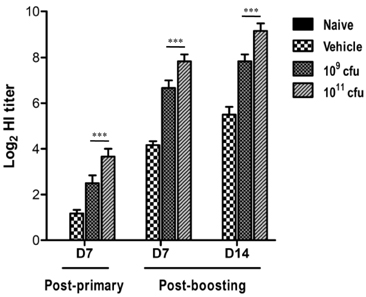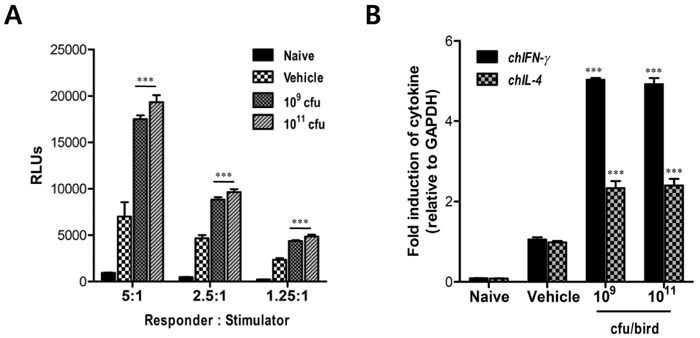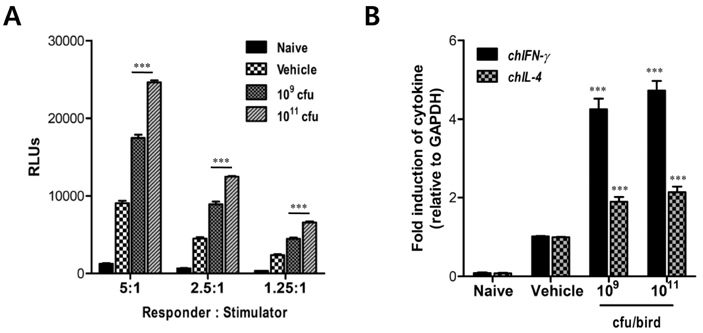Immune Netw.
2013 Feb;13(1):34-41. 10.4110/in.2013.13.1.34.
Modulation of Humoral and Cell-Mediated Immunity Against Avian Influenza and Newcastle Disease Vaccines by Oral Administration of Salmonella enterica Serovar Typhimurium Expressing Chicken Interleukin-18
- Affiliations
-
- 1College of Veterinary Medicine and Bio-Safety Research Institute, Chonbuk National University, Jeonju 561-756, Korea. vetvirus@chonbuk.ac.kr
- KMID: 2150769
- DOI: http://doi.org/10.4110/in.2013.13.1.34
Abstract
- Interleukin-18 (IL-18) has been known to induce interferon-gamma (IFN-gamma) production and promote Th1 immunity. Although mammalian IL-18 has been characterized in great detail, the properties and application of chicken IL-18 remain largely uninvestigated as of yet. In this study, we evaluated the immunomodulatory properties of Salmonella enterica serovar Typhimurium expressing chicken interleukin-18 (chIL-18) on immune responses induced by avian influenza (AI) and Newcastle disease (ND) vaccines. After oral administration of S. enterica serovar Typhimurium expressing chIL-18, chickens were vaccinated intramuscularly with the recommended dose of either inactivated AI H9N2 vaccine or ND (B1 strain) vaccine. Chickens receiving a primary vaccination were boosted using the same protocol 7 days later. Humoral and cell-mediated immune responses were evaluated in terms of HI antibody titers and proliferation and mRNA expression of IFN-gamma and IL-4 of peripheral blood mononuclear cells (PBMC) in response to specific antigen stimulation. According to our results, oral administration of S. enterica serovar Typhimurium expressing chIL-18 induced enhanced humoral and Th1-biased cell-mediated immunity against AI and ND vaccines, compared to that of chickens received S. enterica serovar Typhimurium harboring empty vector. Therefore, we conclude that our proposed vaccination regimen using inactivated AI and ND viruses along with oral administration of S. enterica serovar Typhimurium expressing chIL-18 may provide a novel approach in protecting chicken from currently circulating AI and ND virus strains.
Keyword
MeSH Terms
Figure
Reference
-
1. Fouchier RA, Munster V, Wallensten A, Bestebroer TM, Herfst S, Smith D, Rimmelzwaan GF, Olsen B, Osterhaus AD. Characterization of a novel influenza A virus hemagglutinin subtype (H16) obtained from black-headed gulls. J Virol. 2005. 79:2814–2822.
Article2. Alexander DJ. A review of avian influenza in different bird species. Vet Microbiol. 2000. 74:3–13.
Article3. Butt KM, Smith GJ, Chen H, Zhang LJ, Leung YH, Xu KM, Lim W, Webster RG, Yuen KY, Peiris JS, Guan Y. Human infection with an avian H9N2 influenza A virus in Hong Kong in 2003. J Clin Microbiol. 2005. 43:5760–5767.
Article4. Li KS, Xu KM, Peiris JS, Poon LL, Yu KZ, Yuen KY, Shortridge KF, Webster RG, Guan Y. Characterization of H9 subtype influenza viruses from the ducks of southern China: a candidate for the next influenza pandemic in humans? J Virol. 2003. 77:6988–6994.
Article5. Alexander DJ. Saif YM, editor. Newcastle disease, other avian Paramyxoviruses, and Pneumovirusinfections. Diseases of poultry. 2003. 11th ed. IA: IowaState Press;63–87.6. Senne DA, King DJ, Kapczynski DR. Control of Newcastle disease by vaccination. Dev Biol (Basel). 2004. 119:165–170.7. van Boven M, Bouma A, Fabri TH, Katsma E, Hartog L, Koch G. Herd immunity to Newcastle disease virus in poultry by vaccination. Avian Pathol. 2008. 37:1–5.8. Kapczynski DR, King DJ. Protection of chickens against overt clinical disease and determination of viral shedding following vaccination with commercially available Newcastle disease virus vaccines upon challenge with highly virulent virus from the California 2002 exotic Newcastle disease outbreak. Vaccine. 2005. 23:3424–3433.
Article9. van Oirschot JT. Diva vaccines that reduce virus transmission. J Biotechnol. 1999. 73:195–205.
Article10. Kaiser P. Advances in avian immunology--prospects for disease control: a review. Avian Pathol. 2010. 39:309–324.
Article11. Akira S. The role of IL-18 in innate immunity. Curr Opin Immunol. 2000. 12:59–63.
Article12. Rahman MM, Uyangaa E, Han YW, Kim SB, Kim JH, Choi JY, Eo SK. Enhancement of Th1-biased protective immunity against avian influenza H9N2 virus via oral co-administration of attenuated Salmonella enterica serovar Typhimurium expressing chicken interferon-α and interleukin-18 along with an inactivated vaccine. BMC Vet Res. 2012. 8:105.
Article13. Rahman MM, Uyangaa E, Han YW, Kim SB, Kim JH, Choi JY, Eo SK. Oral co-administration of live attenuated Salmonella enterica serovar Typhimurium expressing chicken interferon-α and interleukin-18 enhances the alleviation of clinical signs caused by respiratory infection with avian influenza virus H9N2. Vet Microbiol. 2012. 157:448–455.
Article14. Hung LH, Li HP, Lien YY, Wu ML, Chaung HC. Adjuvant effects of chicken interleukin-18 in avian Newcastle disease vaccine. Vaccine. 2010. 28:1148–1155.
Article15. Lim KL, Jazayeri SD, Yeap SK, Alitheen NB, Bejo MH, Ideris A, Omar AR. Co-administration of avian influenza virus H5 plasmid DNA with chicken IL-15 and IL-18 enhanced chickens immune responses. BMC Vet Res. 2012. 8:132.
Article16. Ding AH, Nathan CF, Stuehr DJ. Release of reactive nitrogen intermediates and reactive oxygen intermediates from mouse peritoneal macrophages. Comparison of activating cytokines and evidence for independent production. J Immunol. 1988. 141:2407–2412.17. Rahman MM, Uyangaa E, Han YW, Kim SB, Kim JH, Choi JY, Yoo DJ, Hong JT, Han SB, Kim B, Kim K, Eo SK. Oral administration of live attenuated Salmonella enterica serovar Typhimurium expressing chicken interferon-α alleviates clinical signs caused by respiratory infection with avian influenza virus H9N2. Vet Microbiol. 2011. 154:140–151.
Article18. Pollock KG, Conacher M, Wei XQ, Alexander J, Brewer JM. Interleukin-18 plays a role in both the alum-induced T helper 2 response and the T helper 1 response induced by alum-adsorbed interleukin-12. Immunology. 2003. 108:137–143.
Article19. Schneider K, Puehler F, Baeuerle D, Elvers S, Staeheli P, Kaspers B, Weining KC. cDNA cloning of biologically active chicken interleukin-18. J Interferon Cytokine Res. 2000. 20:879–883.
Article20. Göbel TW, Schneider K, Schaerer B, Mejri I, Puehler F, Weigend S, Staeheli P, Kaspers B. IL-18 stimulates the proliferation and IFN-gamma release of CD4+ T cells in the chicken: conservation of a Th1-like system in anonmammalian species. J Immunol. 2003. 171:1809–1815.
Article21. Degen WG, van Zuilekom HI, Scholtes NC, van Daal N, Schijns VE. Potentiation of humoral immune responses to vaccine antigens by recombinant chicken IL-18 (rChIL-18). Vaccine. 2005. 23:4212–4218.
Article22. Su BS, Shen PC, Hung LH, Huang JP, Yin HS, Lee LH. Potentiation of cell-mediated immune responses against recombinant HN protein of Newcastle disease virus by recombinant chicken IL-18. Vet Immunol Immunopathol. 2011. 141:283–292.
Article23. Kim SJ, Kim SB, Han YW, Uyangaa E, Kim JH, Choi JY, Kim K, Eo SK. Co-administration of live attenuated Salmonella enterica serovar Typhimurium expressing swine interleukin-18 and interferon-α provides enhanced Th1-biased protective immunity against inactivated vaccine of pseudorabies virus. Microbiol Immunol. 2012. 56:529–540.
Article24. Lee BM, Han YW, Kim SB, Rahman MM, Uyangaa E, Kim JH, Roh YS, Kim B, Han SB, Hong JT, Kim K, Eo SK. Enhanced protection against infection with transmissible gastroenteritis virus in piglets by oral co-administration of live attenuated Salmonella enterica serovar Typhimurium expressing swine interferon-α and interleukin-18. Comp Immunol Microbiol Infect Dis. 2011. 34:369–380.
Article25. Beal RK, Powers C, Davison TF, Barrow PA, Smith AL. Clearance of enteric Salmonella enterica serovar Typhimurium in chickens is independent of B-cell function. Infect Immun. 2006. 74:1442–1444.
Article26. Beal RK, Wigley P, Powers C, Hulme SD, Barrow PA, Smith AL. Age at primary infection with Salmonella enterica serovar Typhimurium in the chicken influences persistence of infection and subsequent immunity to re-challenge. Vet Immunol Immunopathol. 2004. 100:151–164.
Article27. Steidler L, Neirynck S, Huyghebaert N, Snoeck V, Vermeire A, Goddeeris B, Cox E, Remon JP, Remaut E. Biological containment of genetically modified Lactococcus lactis for intestinal delivery of human interleukin-10. Nat Biotechnol. 2003. 21:785–789.
Article28. Rupa P, Monedero V, Wilkie BN. Expression of bioactive porcine interferon-gamma by recombinant Lactococcus lactis. Vet Microbiol. 2008. 129:197–202.
Article
- Full Text Links
- Actions
-
Cited
- CITED
-
- Close
- Share
- Similar articles
-
- Salmonella Serovars from Foodborne and Waterborne Diseases in Korea, 1998-2007: Total Isolates Decreasing Versus Rare Serovars Emerging
- Streptococcus mutans Strains Isolated in Korea Can Hardly Metabolize Exogenous Nitric Oxide
- Salmonella Promotes ASC Oligomerization-dependent Caspase-1 Activation
- Prevalence of Specific Clone of Salmonella enterica Serovar Typhimurium Clones in the Swine Population of Kyungpook Province During 1998 to 2000
- Protection Against Salmonella Typhimurium, Salmonella Gallinarum, and Salmonella Enteritidis Infection in Layer Chickens Conferred by a Live Attenuated Salmonella Typhimurium Strain





